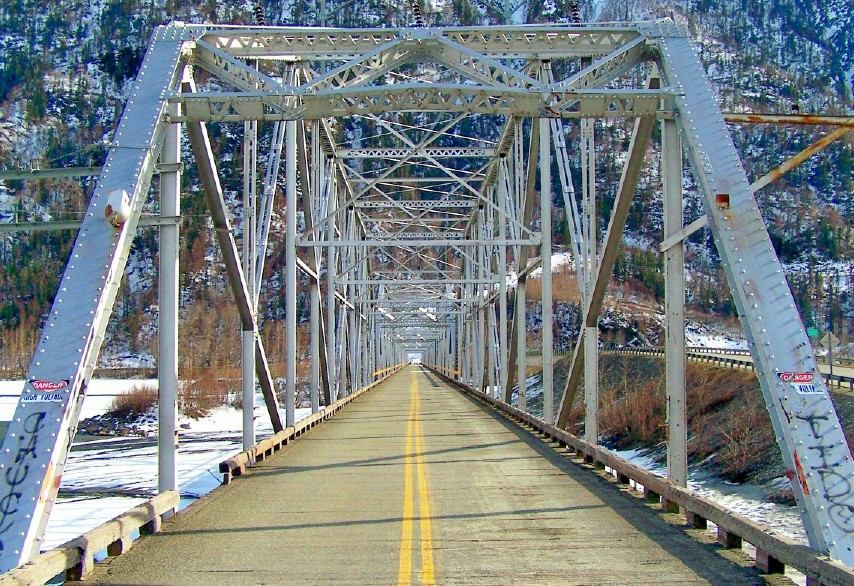
By Karla Fetrow
From Wagon Trail to Highway
Tell any New Alaskan you plan to take a drive up the Richardson, and it will be immediately assumed you’re referring to that meandering strip of road between Valdez and Fairbanks, giving you access to Wrangell St. Elias Park; an astonishing wilderness enclave and the largest National Park in the United States. However, say this to any died in the wool, veteran Alaskan, and that person will immediately know that you mean you’re planning to use the road that was once the only passage into Alaska.
The Richardson underwent a great deal of metamorphosis over the years. It was first punched out as a wagon trail for gold prospectors in the late 1800’s. The monies appropriated for this project came grudgingly. The US Government and budget watching citizens were still not convinced that the purchase of Alaska was a wise investment, and still referred to it as “Seward’s Folly”. However, gold was already being removed from the Port of Valdez at an astonishing rate, and newspapers were ringing to the sound of Klondike gold in the Dawson Creek beds and along the Alaskan border. There was one major problem. The primary routes leading to the gold camps were on Canadian soil, and two of them, the Ashcroft and Edmonton, for the entire length.
In 1898, as the gold rush was at its peak, the U.S. Army sent exploration teams to Alaska to locate a practical “All-American” route. The main corridors under initial consideration were the Susitna and Matanuska Valleys at the head of Cook Inlet, and the Copper River area. Heavily promoted by the Pacific Steam Whaling Company, a transport trail was carved out over the top of Valdez Glacier. Beside the regular government crew and surveyors, much of the architecture of this extremely hazardous route was turned over to destitute prospectors who labored for fifty dollars a month, plus board. With nothing, really to spend their money on, many of the workers finished this initial ninety-three miles through gnashing cliffs, treacherous avalanche areas and unstable glacial ground, with enough cash to start their lives over elsewhere – but many more died in the attempt.
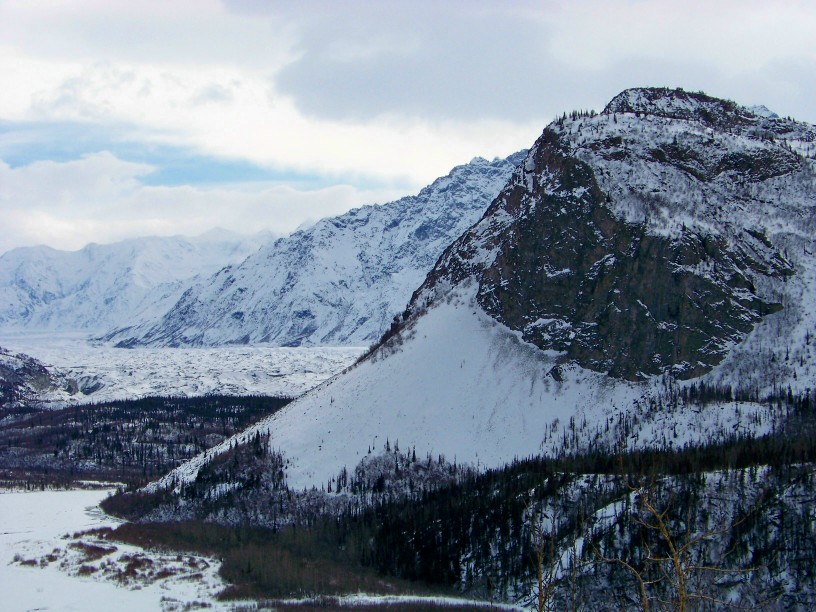
The highway, which closely follows this early trade route through Thompson Pass is still a harrowing journey winding past wide mouthed gorges, crystalline waterfalls, and boulders standing like stone age sentries. In seven miles, your vehicle has climbed 2,500 feet. The highway idled in its infantry, but not for long. In 1903, gold was discovered in what is now the town of Fairbanks, and the push to extend the wagon trail into interior Alaska hit the political floor. The trade route, that had begun as a means of connecting the Port of Anchorage and the Port of Valdez by land, was becoming a spider web, with the summit town of Glenallen as the center. From Glenallen, you could turn southeast to Valdez, south central to Anchorage, or north west to Fairbanks. Not far from Glenallen, is yet another branch of the now diversified Richardson; the turn off for Tok Junction; the last Alaskan outpost before crossing the Canadian border.
The Richardson politely refrained from calling itself the Richardson once it crossed over into Canada, primarily because the Canadians had already built their own rudimentary road and called it the Dawson, but for many long years, if you were traveling north by highway, you were taking the Richardson.
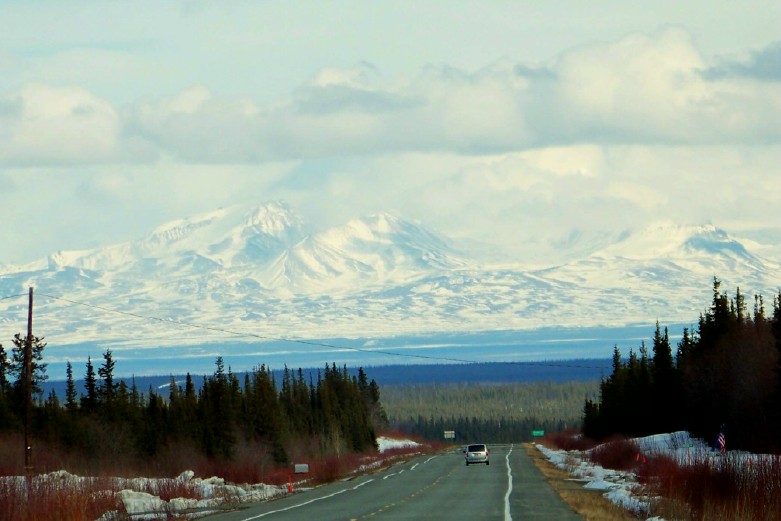
The Parks Diversion
This was all before the Parks Highway was built. Some strange sense of etiquette required that the name “Glenn” that was used to designate the road that had previously connected Wasilla, Anchorage and the Kenai Pennisula, be preserved by calling the tattered, interrupted, broken road left in the wake of creating the Parks, “the Old Glenn”. This generously included the passage through Butte and its winding intent toward Sutton and Chickaloon, while the four lane speedway that bypasses the gently nestled rural communities as it trundles happily between the Matanuska Valley and Anchorage, is the “New Glenn”. The New Glenn disappears somewhere in Wasilla, but it’s not known where.
The creation of the Parks Highway, which cuts nearly a hundred miles of travel time between Anchorage and Fairbanks, did more than change the name and demographics of Alaska’s first road system, and designate the Richardson to a pitiable four hundred mile stretch. Glenallen was no longer the northern hub for trade. The bustling frontier town began to fade as trucks chose the routes of the shorter and far less perilous Parks Highway on their way with deliveries to Anchorage. Tourists, eager to view Denali (McKinley for those who don’t speak Alaskani) up close and with ease, chose the Parks for its circumference to the Denali recreational area. The charms of the Richardson Highway were forgotten.
Glenallen and other small outposts along the Richarson now turned Old Glenn, have struggled hard over the years to sustain an income from what had once been thriving road traffic. Although there is some evidence of a reviving economy; brand new structures stand gleaming in the sun, an occasional, fashionable house spreads its triumphant foundations, many of the homes are in disrepair, with numerous old vehicles and rusting machinery in the yards. The rotting timbers of early settler houses crumble in the middle, and stare blankly in amazement at their abandonment.
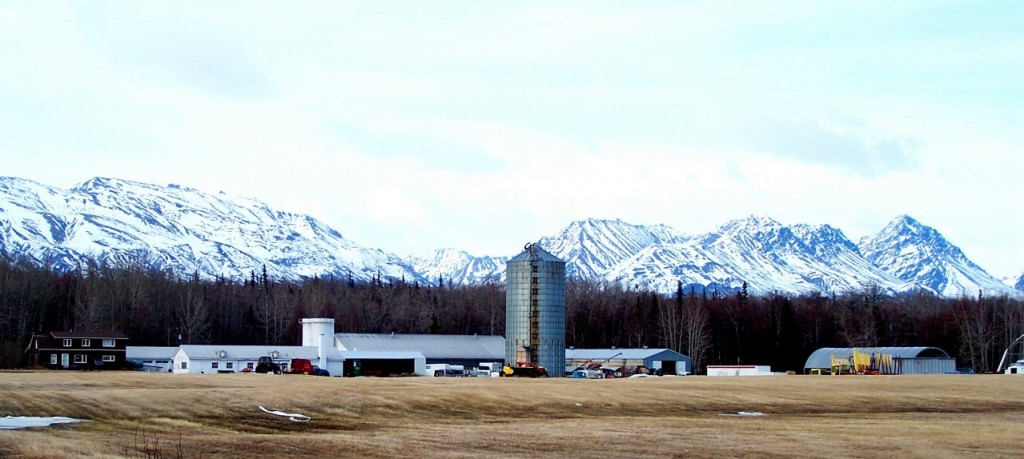
It’s true you won’t see the Big Boy from the Richardson, old stone faced Denali with his severe winter breath. It’s also true you’ll be driving on one of the most hair-raising roads designed by man. However, the Richardson breathes of wild, untamed country. Leaving behind Palmer, heaving with gentle farms nestled into a valley carved by the Matanuska Glacier and its thundering water head, you begin immediately climbing the Chugach Range. Within minutes, you are snaking around cliffs with seven hundred foot drop-offs revealing the churning, restless Matanuska River. The Matanuska has no boundaries. Each spring, it changes its voracious path, pulling up trees by their roots, swallowing embankments, carving new paths through the canyons. Within minutes, you are entering the tiny town of Sutton, and suddenly feel you are in “the real Alaska”.
The real Alaska isn’t easy to find anymore. Like a botanist following the trail of a specific species to its flourishing fields, it’s identified first in the stragglers left behind in the energetic high-cost, post pipeline, housing push Not everyone who lived in Alaska before the advent of the pipeline signed up to work with the oil companies, nor joined the rambunctious tourist trade that followed. Those who didn’t were shoved aside and forgotten. You see them in their once stately cabin homes, the painted totems and blue trimmed rafters now blistered and fading. You see them in the yards filled with indigenous shrubs and fruit baring bearing bushes, thick and flourishing with fifty years of cultivation. The yards are deeper, greener. The scrape and seed lawns of imported grass can neither compare or compete with the wild disorder of nature’s carpet. These yards slumber while around them, hills are leveled, the spongy glacier soil graveled, and suburban homes and businesses spring up like popcorn.
Petrified Trees and Drunken Forests
Sutton is famous for its anti-corporate stand. It has repeatedly shut down efforts to expand mining in its giant coal fields. It has ignored attempts to establish chain businesses, preferring their local gas stations and restaurants to the slick, polished new hopefuls. It ran its assembly representative out of town and burned an effigy in his yard when it was discovered a proposal being considered for natural gas development would remove all the home owners’ sub-surface rights to deeded property.
Sutton is the first benchmark into a geologist’s paradise. High in the coal ridges between Sutton and the Matanuska Glacier, are the fossilized trunks of giant trees. Written in the frozen resin; now turned amber; in the piles of leaves and shrubs forever captured in slate, is the marvelous proof that Alaska had once been tropical. Deep in the canyons carved by the receding glaciers, are thunder eggs, amethyst, jade and gold. Arriving at these deposits is a challenging task. Following the bed line carries you into strange, twisted canyons, with sharp rocks rising and falling from upended cliffs. Here, not only has the earth had to contend with the brutal force of water, but the Talkeetna’s, located on a converging line between the Chugach and Alaska, gnashes and grinds its way to the top as its own mountains. The Talkeetna’s grow an average of one inch a year. During the 1964 Anchorage earthquake, it grew an estimated four inches. When you are in the jaws of the Talkeetna’s, yawning patiently open, undecided whether to devour you or not, you become acutely aware that you are in an earthquake zone.

By remaining on the Richardson, now with proper propriety called the Old Glenn, you soon enter a wildlife enthusiast’s paradise. Dotting the mountains like specks of moving snow are Dahl sheep and mountain goats. The viewing is best, surprisingly, at a place called Sheep Mountain. For those who drive slowly enough to catch a glimpse into the rustling bushes, the rewards are pleasant; foxes with round, startled eyes, waddling porcupine, a baby moose, with the mother watchfully guarding it from a thicket. If you are lucky, you’ll see herds of caribou migrating across the tundra. In the past, caribou sightings were frequent. On any given day, you could see them in the valleys or grazing casually near the highway. However, development and snow machines have caused them to change their migrational routes and favor more deeply interior passage.
One of the bizarre aspects of Alaska’s evolving environment are what we call, “the drunken forests”. Permafrost once covered most of Alask’s sub-soil surface. Depending on demographic location, you could dig two feet into warm soil before hitting permafrost, or find it just inches under the moss covered blanket that characterizes the tundra. The tundra has been thawing and the permafrost receding. The fir and spruce, accustomed to attaching their roots to firm, nearly frozen soil, look for stabilizing factors in the marsh as the frost melts, saturating the ground with water. The young trees quickly adjust to their new environment, but the older ones twist and turn in their growth, their roots too short and shallow to remain a strong foundation. They shift drunkenly to one side, and when the sunlight brings their attention to the fact that they are staring at the ground, not the sky, bend precariously in the opposite direction to remedy the situation. All through the sunbathed summit of the Chugach are regions of melting permafrost and their drunken forests.
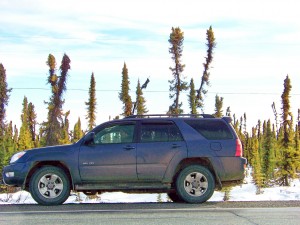
It’s difficult to turn a drive up the Old Glenn to the Richardson Highway into an afternoon pleasure trip when the heart is reluctant to turn back. With each curve in the road, there is a new landscape, a breathtaking adventure to explore. The Old Glenn sidles by three glaciers; the Eklutna, the Knik and The Matanuska. Someday soon, the industry of corporate life will tidy up the rustic aspects of the Old Glenn, the quaint little towns with its humble churches and equally bawdy taverns, the rusting signs of homesteaders who made their livelihood from farming, trapping or prospecting, the first, colorful prints of history to overlay their bland imitation of culture, but until then, the journey remains a gateway into another time, another era in history, another people living out a dream that is being quietly moved into the background. For them, the Richardson is anywhere along the road that leads up over the settlement of Sutton and heads north toward Glenallen, then southeast to Valdez.

Everytime I read your articles about your state makes me want to come up and experience Alaska. Not the tourist Alaska but the Alaska you write about. Your pictures are wonderful. I’d love to sit in a diner in Sutton or Palmer and easedrop on the conversations of the locals. Perhaps striking up conversation and hearing their stories. Your articles never cease to stimulate my imagination and tap into the travel bug in me.
Thank you, PBugnacki. There is so much difference between the traveler and the tourist. The tourist sees only what was designed for him to see. The traveler learns about the people. Your choice for a restaurant is a good one. Between Palmer and Glenallen are the most wonderful mom and pop restaurants and cafeterias. The french fries are made from real potatoes, sliced and set to popping straight from the bag, not the freezer. The hamburgers are enormous and made from real beef, not half bread crumbs blended together in a patty. In many of them, you can still find a juke box in the corner for cranking out your favorite music. But the best part about these home-cooked meals are the pies! Incredible, wonderful, enormous variety of pies. You don’t really even need a meal; just some pie and coffee and you’re in heaven.
Terrific work! This is the type of information that should be shared around the web. Shame on the search engines for not positioning this post higher!
This oil spill could get really bad if the leak can’t be fixed. We always think our scientists know everything, but you can’t beat mother nature. At any rate, I hope Obama’s administration’s efforts pay off. It seems like they’re trying.
Hello there, You craft some good blogs, I love nearly all of your articles or blog posts. I always check back here often to see if you have kept up to date. Continue blogging!